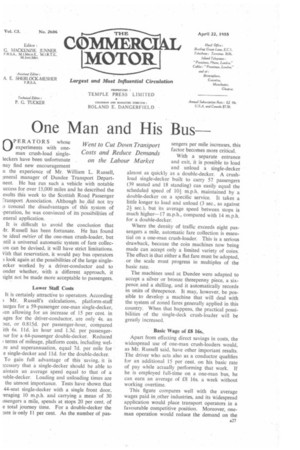One Man and His Bus
Page 29

Page 30

If you've noticed an error in this article please click here to report it so we can fix it.
OPERATORS whose experiments with oneman crush-load singleleckers have been unfortunate nay find new encouragement n the experience of Mr. William L. Russell, ;eneral manager of Dundee Transport Departnent. He has run such a vehicle with notable uccess for over 15,000 miles and he described the esults this week to the Scottish Road Passenger Eransport Association. Although he ,did not try o tonc,eal the disadvantages of this system of ,peration, he was convinced of its possibilities of eneral application.
It is difficult to avoid the conclusion that 4r. Russell has been fortunate. He has found he ideal métier of the one-man crush-loader, but ntil a universal automatic system of fare collecLon can be devised, it will have strict limitations. Vith that reservation, it would pay bus operators 3 look again at the possibilities of the large singleecker worked by a driver-conductor and to onder whether, with a different approach, it light not be made more acceptable to passengers.
Lower Staff Costs It is certainly attractive to operators. According ) Mr. Russell's calculations, platform-staff larges for a 59-passenger one-man single-decker, ien allowing for an increase of 15 per cent. in ages for the driver-conductor, are only 4s. an our, or 0.815d per passenger-hour, compared ith Gs. 11d. in hour and 1.3d. per passengerour for a 64-passenger double-decker. Reduced I terms of mileage, platform costs, including welre and superannuation, equal 7d. per mile for e single-decker and 11d, for the double-decker. To gain full advantage of this saving, it is .sessary that a single-decker should be able to aintain an average speed equal to that of a )uble-decker. Loading and unloading times are the utmost importance. Tests have shown that 44-seat single-decker with a single front door, reraging 10 m.p.h. and carrying a mean of 30 issengers a mile, spends at stops 20 per cent, of e total journey time. For a double-decker the !ure is only 11 per cent. As the number of pas sengers per mile increases, this factor becomes more critical.
With a separate entrance and exit, it is possible to load and unload a single-decker almost as quickly as a double-decker. A crush load single-decker built to carry 57 passengers (39 seated and 18 standing) can easily equal the scheduled speed of 101 m.p.h. maintained by a double-decker on a specific service. It takes a little longer to load and unload (3 sec., as against 21 sec.), but its average speed between stops is much higher-17 m.p.h., compared with 14 m.p.h. for a double-decker.
Where the density of traffic exceeds eight passengers a mile, automatic fare collection is essential on a one-man crush-loader. This is a serious drawback, because the coin machines now being made can accept only a limited variety of coins. The effect is that either a flat fare must be adopted, or the scale must progress in multiples of the basic rate.
The machines used at Dundee were adapted to accept a silver or bronze threepenny piece, a sixpence and a shilling, and it automatically records in units of threepence. It may, however, be possible to develop a machine that will deal with the system of zoned fares generally applied in this country. When that happens, the practical possibilities of the single-deck crush-loader will be greatly increased.
Basic Wage of 18 16s., Apart from effecting direct savings in costs, the widespread use of one-man crush-loaders would, as Mr. Russell said, have other important results. The driver who acts also as a conductor qualifies for an additional 15 per cent. on his basic rate of pay while actually performing that work. If he is employed full-time on a one-man bus, he can earn an average of E8 16s. a week without working overtime.
This figure compares well with the average wages paid mother industries, and its widespread application would place transport operators in a favourable competitive position. Moreover, oneman operation would reduce the demand on the labour market by about half and would make matters easier for everyone.
To man duplicate vehicles at the morning and evening peak periods, a high percentage of spreadover duties is necessary. If one-man buses could be used as duplicates, the number of employees engaged in spread-over duties would be halved and transport staffs should, in consequence, be more contented.
This is the obvious role of the one-man crushloader and, as a high proportion of the stage carriages in this country is used only at peak periods, it should theoretically have a wide application. The difficulty is, however, to collect zoned fares quickly enough to enable a reasonable average speed to be maintained.
In addition, there is a strong public aversion to be overcome. Mr. Russell seems to have found the secret, for he said that passengers in Dundee were willing to pay a flat threepenny fare for a twopenny stage, rather than await the next bus. In most other places where the experiment has been tried, passengers have preferred to wait in the road, rather than to stand in a bus, even when fares are equal.
It is possible that the advantages of the operation of crush-load single-deckers have not been properly explained to the public in advance of their use. If the full facts were skilfully publicized, passengers might be willing to accept the minor hardship of standing for a short journey, in return for some assurance of stability in fares, or even a reduction in them.
It might pay urban operators to consider whether large one-man single-deckers could be employed at flat fares on certain routes during peak periods. If public confidence could be won in small-scale experiments, the way would be paved for the wider use of this type of vehicle. At off-peaks, for which a seating capacity of 39 should be more than adequate, it could be operated as a normal single-decker.




























































































